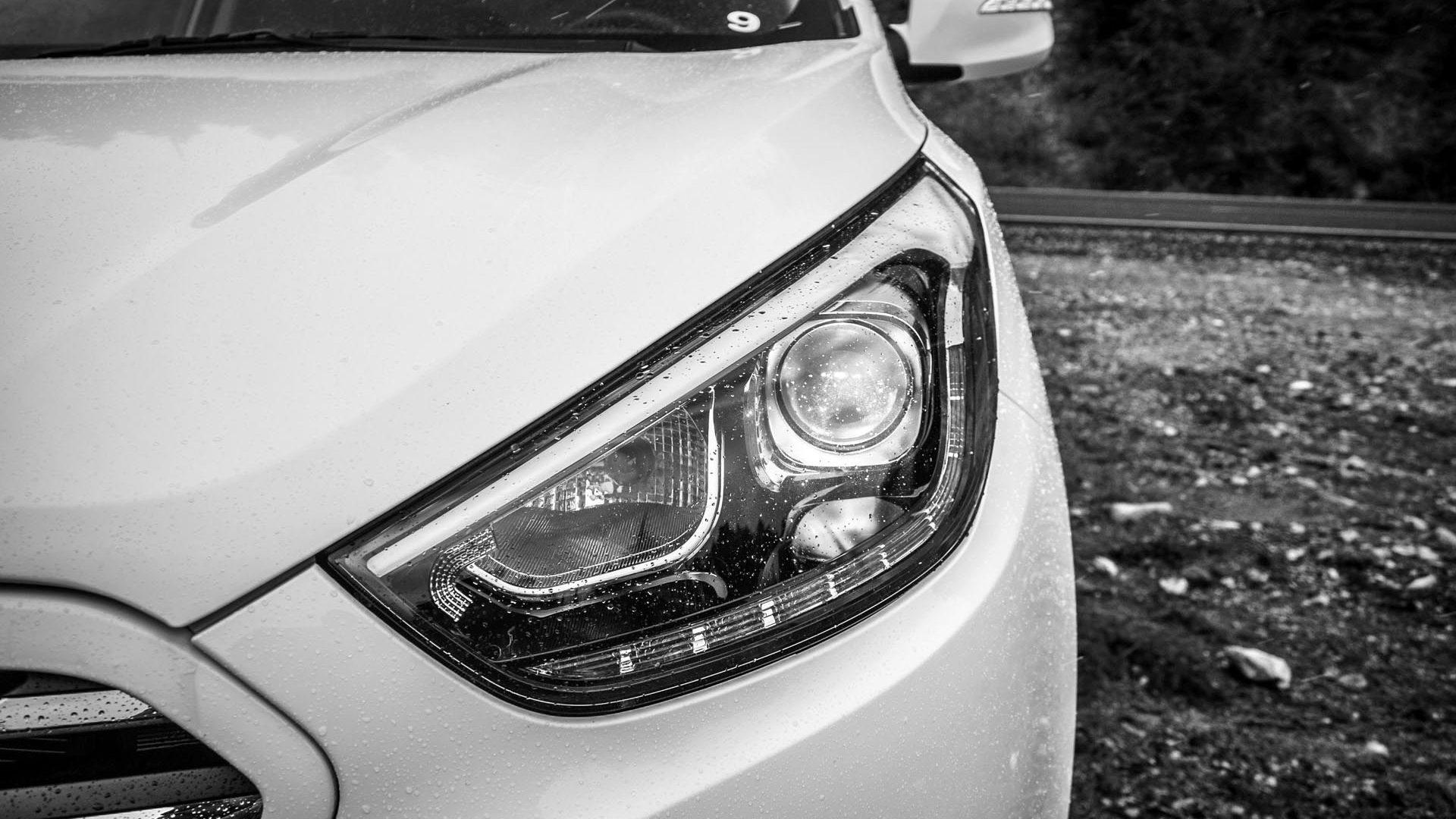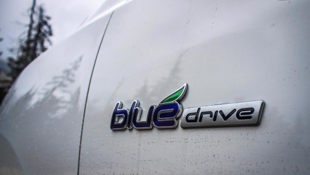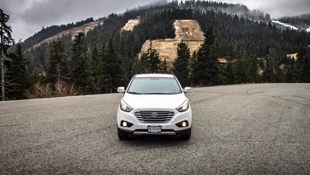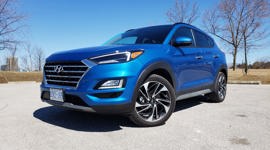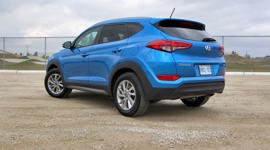 AutoTrader SCORE
AutoTrader SCORE
-
EXTERIOR STYLING7/10
-
INTERIOR7/10
-
PERFORMANCE6/10
-
COMFORT7/10
-
FUEL ECONOMY10/10
First, an argument: what is a motor, and what is an engine? This is the sort of debate that tends to plague the comments on any sort of electrically powered vehicle, causing much name-calling and e-bloodshed. There's an easy out when internal combustion is involved – you just call the motivating device a “mill” or “powerplant” or (my personal favourite) a “stove.”
Why would anyone bother with a more complex fuel cell vehicle? And where does one buy hydrogen – your local zeppelin hangar?
“Hey bud, that thing got the big stove option?”
“Yeah right she does, bud!”
“Oh right on, eh – let's take 'er for a rip!”
And *scene*. But what about this Hyundai? Pop the hood and there's this sort of complicated apparatus that looks like an industrial dishwasher. What's a “fuel cell”? Be it engine? Be it motor? Be it witchcraft? As it turns out – all three, sort of.
Let me come back to our argument briefly. There is a belief held in the automotive world that engine refers to combustion-derived motive power and motor to electrical power. So sayeth Wikipedia, but it's wrong: a motor is anything that transforms one kind of energy into mechanical work, whereas an engine is anything that creates motive force by consuming fuel. The finer points of the definition involve the sort of fracas between lab-coat-wearing eggheads that you see in Far Side cartoons, but let's defer to MIT's assessment that the words are, in modern usage, nearly synonymous.
And anyway, a fuel-cell powered vehicle is technically both motor and engine. The fuel-cell stack consumes fuel in the form of compressed hydrogen gas, stripping electrons as the H2 reacts with oxygen from the air to produce water and electricity. The electricity is then used to power electric motors to turn the wheels, and there are regenerative brakes as in a hybrid.
This is the only hydrogen-powered fuel-cell vehicle you can buy in Canada, the Hyundai Tucson Fuel Cell Electric Vehicle, which we'll call FCEV for brevity. Sorry, that's incorrect: you can't actually buy the Tucson FCEV. You may lease it for $599 a month over three years, with a required down payment of $3,995. Oh, and you can't just waltz into a dealership either, you have to sign up online as a sort of beta tester and hope your application is picked.
Despite this somewhat convoluted process, Hyundai reports that demand is far outstripping supply. To be fair, supply is only currently sitting at two cars, both delivered in BC, but there does seem to be a considerable clamour for the car. Given the large number of electric vehicles available to the buying public (last year Nissan sold nearly 1,000 Leafs), why would anyone bother with a more complex fuel cell vehicle? And where does one buy hydrogen – your local zeppelin hangar?
Certainly there's not much on the surface to indicate that this version of the Tucson is anything unusual. There's a bit of extra badging out back and on the flanks, but other than that it could be just another hybridized crossover. Out getting organic groceries or filling up growlers at a local zero-waste brewery, it attracted neither comments nor second looks.
On the inside, it's pretty much the same story. This car is like any other high-option Tucson, apart from the lack of a sunroof. It looks fairly ordinary inside, devoid of specialized screens and gauges, and while the trunk space is fractionally reduced by the rear-mounted pressure tank, it's entirely practical. The cargo area of the plug-in version of the Ford C-Max is way more useless than this.
Part of the reason Hyundai is able to create a fuel-cell version of an existing car rather than developing something futuristic-looking like Honda's FCX Clarity or deranged like Toyota's Mirai is the compactness of their powertrain. Electric motors don't take up much space, it's the batteries that are ordinarily the space-hogs. Hyundai's fuel-cell stack is almost exactly the same size as a regular four-cylinder engine, so despite the fuel tank being a little larger than usual, packaging concerns aren't really an issue.
However, the complexity and expense of the device – that's something else entirely. Fuel-cell stacks are composed of multiple layers of sandwiched membranes, and a lot of platinum is used in their construction. Think of it as the world's most expensive cube of Potato Galette and you'll get the idea. In its homeland of South Korea, this thing is the equivalent of $80,000. That $599 a month is a pretty good deal.
Turn on the Tucson FCEV and after an instant's pause, the display chirps “Go!” Okay then – but the modest 134 hp available from the small electric motor has its work cut out to shift 1,900 kg of crossover. There's 221 lb-ft of instantly available torque, so the FCEV's initial off-the-line scoot feels decent, but above 40 km/h acceleration is so-so. On-ramp merging is performed without drama but you'd better not be in a particular hurry.
In all other respects, it's a Tucson. The interior is comfortable, if a little spartan; with the improvements made for the 2016 Tucson fresh in my mind from its New York reveal, it's hard not to find fault. However, it is relatively spacious in here, with room for a rear facing child seat and comfortable seats. As far as practicality goes, the FCEV wouldn't be a stretch for a young family.
Moreover, the navigation proved itself quite likable, even figuring out afternoon traffic and creating a detour route through the exact same secret neighbourhood backroads we use. There are heated seats and USB and AUX ports up front where they're supposed to be. Apart from the lack of cruise control, it's a perfectly ordinary and usable machine.
The problem comes when it's time to start thinking about fuelling the FCEV, a conundrum that comes with the most black and white good-news/bad-news situation ever. The Good News: fuelling up is free! The Bad News: there's only one place you can do it.
While the Tucson FCEV has a perfectly acceptable claimed 426 km range, the simple fact is that in BC you're tethered to a single hydrogen refuelling station in Surrey. Powertech labs, BC Hydro's research and development station, is the only place with a 10,000 psi station capable of recharging the FCEV's gas tank. The process is simple enough – hook up your pump, key in a PIN, press go – and topping off takes all of five to ten minutes. In this it's much like a gasoline-powered car, but start driving around in town a bit and you'll be wondering why the navigation even lists Chevrons and Shells. You can't gas this thing up at them.
It's the infrastructure that's the issue, something we've all heard about fuel-cell technology for years. And so, the argument begins that it's going to be battery-based EVs that are the way forward, that hydrogen is a dead-end technology. No, say others, it's the clean-running small-displacement gasoline cars that are the way forward, or hybridized diesel machines, or range-extenders strapped to electric vehicles.
Just as with the motor/engine debate, the argument over which technology is most viable is a pointless one. In all likelihood, we'll need EVs, internal combustion engines, and fuel-cell vehicles to fill our transportation needs, depending on application. Right away, I can tell you that fuel-cell-powered fleet vehicles (postal, delivery, etc.) would be a great fit for the tech, if a central location for filling is required. A clean source of power for generating the gas is an issue, but if it's from hydroelectricity rather than natural gas sources, fuel-cell cars can be simply another way of shifting clean power from major sources to fill our transportation needs.
I took the FCEV up our local ski-hill for photos at the end of a week of puttering around happily and quietly in urban traffic. We had a rotten ski season for the local hills this year, with the twin-peak of the Lions bare of snow for weeks. Back East the snows fell without end, but in the West, things are changing.
The Tucson FCEV is a remarkable achievement in that it's so unremarkable as a car. Bring the level of high-pressure fueling stations in the lower mainland to five or so, and it'd be almost without drawback. Right now it's still just a first taste of one way we might get around in the future.
Note: While clean energy rebates vary from province to province, BC's program will extend to a $6,000 rebate on the Tucson FCEV. The monthly lease payment will change to $529/mo with 0 down.
Pricing: 2016 Hyundai Tucson FCEV
$599/mo over 36 mo. with $3,600 down.
| Warranty: 5 years/100,000 km; 5 years/100,000 km powertrain; 5 years/unlimited distance corrosion perforation; 5 years/unlimited distance 24-hour roadside assistance Competitors: |
| Model Tested | 2016 Hyundai Tucson FCEV |
|---|---|
| Base Price | 25164 |
| A/C Tax | |
| Destination Fee | |
| Price as Tested |







